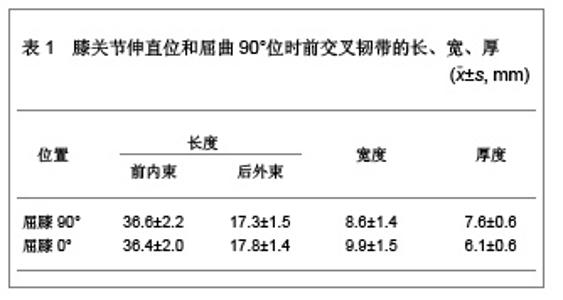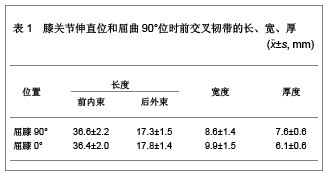Chinese Journal of Tissue Engineering Research ›› 2013, Vol. 17 ›› Issue (8): 1441-1448.doi: 10.3969/j.issn.2095-4344.2013.08.019
Previous Articles Next Articles
Artificial ligament repairs the injured cruciate ligament of the knee joint
Yu Miao, Liu Yi-bing
- Jilin Institute of Physical Education, Changchun 130033, Jilin Province, China
-
Received:2012-06-18Revised:2012-08-27Online:2013-02-19Published:2013-02-19 -
Contact:Liu Yi-bing, Doctor, Professor, Master’s supervisor, Jilin Institute of Physical Education, Changchun 130033, Jilin Province, China 549338018@qq.com -
About author:Yu Miao★, Master, Lecturer, Jilin Institute of Physical Education, Changchun 130033, Jilin Province, China 541798016@qq.com
CLC Number:
Cite this article
Yu Miao, Liu Yi-bing. Artificial ligament repairs the injured cruciate ligament of the knee joint[J]. Chinese Journal of Tissue Engineering Research, 2013, 17(8): 1441-1448.
share this article
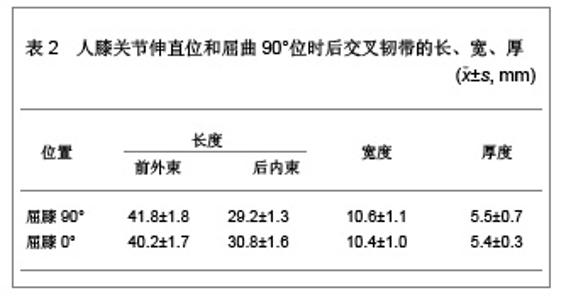
膝关节前交叉韧带功能包括[9]:①限制胫骨前移,当切断膝关节前交叉韧带后,无论在伸膝位或屈膝位前抽屈试验均为阳性。②限制过伸,在膝关节前交叉韧带切断后,膝关节可过伸25°。③限制内、外旋活动,除内侧关节囊及侧副韧带的作用外,第二位是膝关节交叉韧带的限制作用。④限制内、外翻活动,在限制膝内、外翻活动中主要是膝内侧副韧带、外副韧带,其次是膝关节前交叉韧带、后交叉韧带的作用较小。 1.2 后交叉韧带 呈扇形,起于股骨内侧髁的外侧面,向下后外方走行,止于胫骨髁间棘后部。 后交叉韧带分为前外束和后内束,屈曲时,前外侧束紧张,后内侧束松弛,伸直时,前外侧束松弛,后内侧束紧张。后交叉韧带是膝关节最强大的韧带,是主要的稳定装置之一。它的主要功能是防止胫骨过度后移,对限制膝关节外旋和内外翻也起一定作用。膝关节处于伸直位或屈曲90°位时,后交叉韧带前外束和后内束的长度、厚度和宽度[7],见表2。"
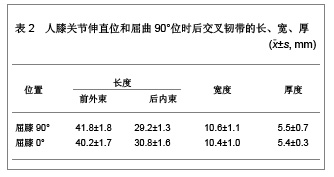
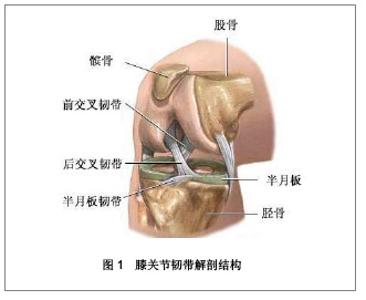
膝关节后交叉韧带功能包括:①限制胫骨上段后移,在屈膝位时这一功能发挥得尤为突出,但在实验性单纯切断膝关节后交叉韧带的现象,还有明显分歧。②限制过伸,在限制膝过伸时作用最大的是后关节囊,其次才是膝关节后交叉韧带,最后是膝关节前交叉韧带。③限制旋转,在切断膝关节后交叉韧带的试验中,屈曲位外旋活动平均增加8°,内旋活动增加3°,而伸直位旋转活动无改变。④限制侧方活动,在伸直位限制膝关节侧方活动中,膝关节后交叉韧带比膝关节前交叉韧带发挥着更重要的作用。 1.3 膝关节韧带的组织结构 膝关节是人体最大、最复杂的关节,由股骨下端、胫骨上端和髌骨构成。髌骨位于髌韧带内。股骨与胫骨之间有纤维软骨半月板,膝关节的韧带为各关节中最复杂的,根据功能可分为伸膝韧带、侧副韧带、交叉韧带和弓状韧带。其中,膝关节交叉韧带位于关节囊内,但在滑膜囊之外,位于膝关节前面的滑膜囊后壁之外[8]。前、后交叉韧带的解剖结构如图1。"
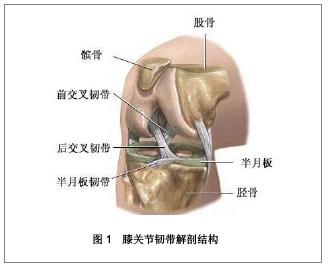

膝关节交叉韧带为膝关节重要的稳定结构,呈铰链式连于股骨髁间窝及胫骨的髁间隆起之间,可防止胫骨沿股骨向前后移位。膝交叉韧带又可分为前后两条交叉韧带,当膝关节活动时,两条韧带各有一部分纤维处于紧张状态。因此,除前交叉韧带能防止胫骨向前移位,后交叉韧带能防止腿骨向后移位外,还可限制膝关节的过伸、过屈及旋转活动,交叉韧带损伤常与胫侧副韧带或半月板损伤同时发生。 1.4 膝关节交叉韧带血供形态学特点 膝关节交叉韧带与其他类型的组织相比,其内的血管很稀疏,但正常的生理活动中,韧带内的血管对韧带有重要的营养作用。膝中动脉从髁间窝后口进入膝关节,发交叉韧带支。自前、后交叉韧带近端向前穿至膝关节腔,在滑膜下沿交叉韧带表面由近端向远端分布。为了解膝关节交叉韧带血管分布和血供模式,许多学者通过动物实验对膝关节交叉韧带血供系统的具体形态等进行了观察。 Arnoczky等[17]于1979年在《骨与关节杂志》上发表题名为“犬交叉韧带损伤微血管反应的实验研究”的文章,他在8只犬模型上以墨汁灌注后,观察发现犬的交叉韧带血供特点是韧带内的血管网分布不均,血管口径特点是处于外周则大,而中心部则管径细;韧带血管与骨内血管没有明显的联系;韧带中部存在缺少血管区;韧带的血供来自于滑膜血管网。王守安等[18]于2009年在《中国临床解剖学杂志》发表1篇题为“膝交叉韧带的血供及其临床意义”的文章,通过股动脉红色乳胶灌注并解剖观察、墨汁灌注组织透明、组织切片等方法,研究交叉韧带的动脉来源、分布特点,并测量韧带内微血管密度。发现交叉韧带血供存有中心区为明显的乏血管区、中间段边缘区也相对乏血管、韧带两端血供最丰富,且近侧段好于远侧段等特点。 Dunlap等[19]于1989年在《美国运动医学杂志》上发表的文章中采用定量灌注技术,发现前交叉韧带滑膜的血流量为韧带实质的2倍,应力作用可使血流值降至基础值的1/5,与髌下脂肪垫隔离后,韧带内血流量下降了一半,韧带的骨附着处对韧带没有供血作用。程映华等[20]将狗作动物模型,将两侧髌韧带内侧1/3游离,左侧直接包埋于髌下脂肪垫,右侧髌下脂肪垫切除后将韧带游离置于关节腔。术后2,4,6,8周灌注、取材,观察髌下脂肪垫对游离髌韧带血供重建的影响。结果发现在重建膝关节交叉韧带时,应尽量保留并利用髌下脂肪垫等软组织,包裹替代物,以促进其血循环重建,减少坏死,保持韧带活力,使替代物发挥稳定膝关节的功能。Robinson等[21]于1992年在兔模型的生理性试验中找到了前交叉韧带实质附着处并不给韧带供血的证据。他在兔模型上对前交叉韧带进行了剥除滑膜处理,2周后韧带发生了萎缩,说明交叉韧带的血供至少部分来源于滑膜,韧带的附着区不能对韧带提供维持正常生理活动所需要的血供,并认为滑液虽然有一定的营养作用,但仅依靠滑膜不能维持韧带的正常生理需要的。Clancy等[22]于1981年在《骨与关节杂志》上发表了1篇名为等“猕猴前、后交叉韧带的重建”的文章,他将29只成年猕猴分为重建前交叉韧带19只,重建后交叉韧带10只,结果发现滑膜血管网分出小支穿入韧带,与韧带沿长轴分出的血管网吻合,中部也有缺少血管区,韧带内血管与骨内血管很少有交通。 Wickstrom等[23]于1975年在《放射学》杂志发表文章报道发现了膝关节交叉韧带的股骨附着区血供比胫骨附着区血供丰富,发现了韧带旁血管网,它与韧带内沿纵向分布的血管相吻合。 何正等[24]于2011年对12侧交叉韧带健康成人尸体膝关节进行肉眼和手术显微镜下解剖、组织学断层切片观察,结果发现交叉韧带全段均可见血管纵行交错分布,血管口径呈节段性变化,血管口径(0.03±0.01)-(0.09±0.02) mm。交叉韧带间束中存在大量的血管及脂肪组织,其表面血管口径最大为(0.18±0.04) mm,因此认为交叉韧带本身拥有足够充分的血供来源,存在自我修复的可能。 王守安等[25]通过对成人和胎儿下肢标本经股动脉红色乳胶灌注并解剖观察,以及胎儿墨汁灌注组织透明和组织切片等方法,观察髌韧带的动脉来源、分布特点,并测量胎儿韧带内微血管密度。发现髌韧带的动脉来自膝下外动脉、胫前返动脉、膝降动脉和膝下内侧动脉的分支;胎儿髌韧带不同区域微血管密度不同,以韧带中心部位密度最低。因此,髌韧带中心部为相对乏血管区,对以髌韧带为替代物行交叉韧带重建有重要的临床意义。Arnoczky等[26]通过研究发现交叉韧带外被滑膜皱襞,前交叉韧带的滑膜起自髁间窝后,向前延伸至该韧带的胫骨附着处并与位于髌下脂肪垫的关节囊滑膜组织相延续,该滑膜完全包被韧带且血管丰富,主要来自于膝中动脉的韧带支及膝下动脉的一些小的分支。"


2 膝关节交叉韧带损伤类型 单纯膝关节前交叉韧带损伤:例如单纯前交叉韧带胫骨止点撕脱骨折就是常见的单纯膝关节前交叉韧带损伤之一,常由于急速减速致膝关节猛烈过伸所致[10]。也有一部分发生在强迫的屈膝力下伴胫骨髁间棘的撕脱骨折中。 膝关节前交叉韧带合并内侧结构的损伤:多发生在强迫的屈曲外旋中,膝关节后内侧结构是控制膝关节外翻和胫骨外旋的重要结构,一旦遭到强大暴力作用后,内侧副韧带、后斜韧带、关节囊等破裂,将影响膝后内侧角的稳定性。 膝关节前交叉韧带合并外侧结构的损伤:由强迫的屈曲内旋力造成,膝关节前交叉韧带合并外侧结构的损伤比较少见,Ross等[11-12]总结10余年膝关节韧带损伤患者,只有13例诊断膝关节前交叉韧带合并外侧结构的损伤,尚无其他文献报道。 膝关节前交叉韧带合并内外侧结构的损伤:由不同形式的内外翻及旋转力造成。 膝关节前交叉韧带合并后交叉韧带的损伤:多发生于胫骨向后移位和膝关节过伸中。单纯性膝关节前交叉韧带损伤少见,绝大多数为复合性韧带损伤。 单纯膝关节后交叉韧带损伤:单纯性后交叉韧带损伤常因屈膝时胫骨近端受到直接向后的暴力所致,约70%的单纯性后交叉韧带损伤发生于胫骨端,表现为后交叉韧带胫骨止点的撕脱骨折。包括后交叉韧带胫骨和股骨附着点处的撕脱损伤,有完全断裂和部分破裂,实质部撕裂可以是急性的,也可是慢性的。 膝关节后交叉韧带合并后外侧结构损伤:膝关节后外侧结构具有限制胫骨的外旋重要功能,它与后交叉韧带联合作用保证膝关节后外侧方向的稳定性[13-14]。 复合伤:这种损伤包括创伤性脱位、前交叉韧带和后交叉韧带损伤及侧副韧带或旋转不稳定性损伤。"


3 人工韧带修复膝关节交叉韧带损伤 资料来源:检索人工韧带修复膝关节交叉韧带损伤相关研究文献[15-16],检索时间范围1999至2011年,以“膝关节(knee);交叉韧带(cruciate ligament);前交叉韧带(anterior cruciate ligament) ;后交叉韧带(posterior cruciate ligament) ;人工韧带(artificial ligament);韧带损伤(ligament injury) ;人工合成材料(synthetic materials) ;生物相容性(biocompatibility)”为检索词,选取文献32篇[17-48]。 纳入标准:①交叉韧带损伤、交叉韧带部分断裂、交叉韧带完全断裂、累及其它结构的联合损伤。②符合临床及放射学诊断标准,并且为膝关节交叉韧带损伤。③对同一领域的文献选择近期发表或权威杂志的文献。④选取针对性强,相关度高的文献。 排除标准:①不符合膝关节交叉韧带临床及放射学诊断标准。②合并有其他免疫疾病。③排除较陈旧的理论观点。④重复研究的文章。 分析指标:①膝关节交叉韧带损伤的实验研究和临床应用。②人工合成材料重建膝关节交叉韧带。③人工韧带修复膝关节交叉韧带。 3.1 修复膝关节交叉韧带损伤的移植材料分析 修复膝关节交叉韧带的移植材料大体可分为3类:自体移植材料、同种异体移植材料和人工韧带。 常用修复膝关节交叉韧带的自体移植材料为健侧或患侧的股四头肌腱-骨髌腱、半腱肌和股薄肌肌腱、自体腘绳肌肌腱、髂胫束以及胫前或胫后肌腱等,缺点是要受到患者自体肌腱情况和数量的限制,还可能带来相应的取腱并发症。而同种异体移植材料虽然可以避免由自体取腱带来的并发症,但它有感染疾病的风险,还可能存在免疫排斥及愈合延迟,供体来源受限等限制。人工韧带不需再受材料限制,能在更多的张力下固定,可早期功能锻炼,简化手术及显著缩短手术时间,被认为是最有发展前景的重建膝关节交叉韧带修复材料。 目前人工韧带主要有左旋聚乳酸,高强度特种绦纶纤维,长丝碳纤维编织带等[27-28]。按其作用不同可分为3类为永久型人工韧带、支架型人工韧带及框架型人工韧带。 永久型人工材料:主要包括Core-Tex韧带、LARS韧带和Polyflex韧带等,它们具有高拉力强度,但不能与受者发生生物性愈合,故成为“永久型韧带”[29]。 支架韧带:支架韧带是现在常用的韧带增强装置,所用材料又分吸收和不吸收2种,如聚乙烯、碳纤维、涤纶、聚酯等,结构特征与前交叉韧带相似,对重建和修复的韧带起暂时的保护和加强作用,可吸收类支架韧带对术后避免磨屑所致渗出和滑膜炎症有积极作用,且能加强移植物的重塑和在生物力学上的更早的成熟[30]。 框架韧带:框架韧带为开放的编织结构,其框架结构既能提供韧带的保护又能刺激和允许局部胶原组织长入。代表为Leeds-Keio韧带、聚羟基乙酸-涤纶韧带,此种韧带能诱导自身组织生长,最后形成类似韧带的替代作用[31]。 Brunet等[32]于2005年回顾性分析应用人工韧带重建包括14例(1例女性和13例男性),平均年龄27岁,因运动创伤导致膝关节后交叉韧带急性损伤的患者,平均随访36个月(10-88个月),所有患者膝关节不稳定症状消失,均于术后2个月左右恢复正常体育活动,均无急慢性滑膜炎表现。Trieb等[33]于2004年在人工韧带重建后6个月进行活检,活检显示人工韧带完全长入细胞和纤维组织,认为人工韧带具有良好的组织相容性。 敖英芳[34]在2001年发表题名为关节镜下重建膝交叉韧带的临床现状的文章,应用Leeds-Keio人工韧带重建前交叉韧带的临床治疗效果满意,术后可采用快速康复程序,康复快,运动员患者术后早期即可恢复训练与比赛。但值得注意的是Leeds-Keio人工韧带同其它人工材料一样,其生物相容性是需要关注的重点。 Murray等[35]应用Leeds-Keio人工韧带重建18例交叉韧带损伤患者,平均年龄13.3年,随访发现其中5例经关节镜证实Leeds-Keio人工韧带断裂,结果较差,提示应注意人工韧带假体的生物疲劳与体内使用寿命问题。 郭林等[36]在2011年为探讨LARS韧带重建前交叉韧带的手术方法和近期疗效,回顾分析了采用LARS人工韧带重建并获完整随访的80例膝关节前交叉韧带损伤患者临床资料,结果发现LARS人工韧带黏弹性较差,术中需要在偏伸直位固定避免屈曲受限,屈曲位允许移植物有轻微松弛,掌握其特殊手术技巧后重建膝关节前交叉韧带能获得较好的近期疗效。 Lavoie等[37]为比较使用人工韧带重建膝关节前交叉韧带损伤后的稳定性及患者的满意度,根据人工韧带重建膝关节前交叉韧带损伤后造成膝关节骨性关节炎成果分数为患者的满意度的评价标准,对47例患者进行8-45个月的随访,无一例膝关节骨性关节炎的发生,因此认为人工韧带是安全有效的产品。 吴宇黎等[38]为探讨LARS人工韧带在前交叉韧带损伤移植重建中的作用,对2004至2006年间收治的因前交叉韧带损伤行LARS人工韧带重建的18例患者为对象进行回顾性研究,认为用LARS人工韧带重建前交叉韧带早期恢复效果满意,特别适合于运动员的前交叉韧带损伤。 Nau等[39]在2002年进行了一项应用LARS人工韧带与骨-髌腱-骨重建膝关节前交叉韧带的前瞻性对照随机临床试验研究,对1996至1998年间分别应用LARS人工韧带与骨-髌腱-骨重建膝关节前交叉韧带的两组病例进行对比研究发现,随访24个月LARS韧带没有急性滑膜炎的发生,两组均无关节感染及滑膜炎的发生,稳定性方面与骨-髌腱-骨组无差异。范钦波等[40]在2008年发表的关节镜下先进人工韧带加强系统和四股自体半腱肌腱重建前交叉韧带的疗效比较,对42例膝关节前交叉韧带断裂患者分别采用LARS人工韧带和4股自体半腱肌腱于关节镜下重建,探讨LARS人工韧带重建膝关节前交叉韧带的临床效果。结果发现LARS人工韧带重建前交叉韧带可取得与4股自体半腱肌腱相同的近期疗效,且明显缩短康复时间,随访24个月未发现移植术后有滑膜炎等不良反应发生,但最大的缺陷在于其使用寿命的不确定性,有待长期随访。 3.2 人工韧带修复膝关节交叉韧带的固定及影响因素 人工韧带重建后牢固与否的关键在于韧带两端骨隧道中韧带与骨界面的结合的紧密固定程度。因此,人工韧带两端与骨界面结合的问题是人工韧带广泛应用的关键点,然后再根据情况采用相应固定方式。目前应用的的股骨和胫骨固定方式有许多,但滑移和缺乏刚度及强度是很多固定装置的共同问题。膝关节交叉韧带双束重建的固定装置仍处在不断的改良当中。现在临床使用的固定方式主要有骑缝钉、带垫圈螺钉、螺钉柱、金属钮扣等几种。Ishibashi等[41]和Yagi等[42]以纽扣钢板固定股骨端,胫骨端用2号爱惜邦缝线系在6.5 mm螺钉垫圈上进行固定,应用后也观察到良好的临床疗效。Morgan等[43]在2002年则报道了一组双束股骨及胫骨端均用可吸收自攻干涉螺钉固定的案例,认为这种类型固定方式是增加固定强度,重建后全膝关节运动更稳定。Gorschewsky等[44]在2007年将193例前交叉韧带断裂患者进行重建,100例采用进行横行钉和93例采用可吸收螺钉,比较股骨侧可吸收螺钉和横行钉的临床疗效,平均随访29个月,结果显示横行钉组优于螺钉组。 Lee等[45]对40只猪分别使用钛和生物可吸收干涉螺钉比较研究,分析初步固定强度的压接固定技术在重建前交叉韧带中的作用,此动物实验表明,嵌压固定术的失效负荷与界面挤压螺钉相比无显著性差异。刘玉杰等[46]为探讨腘绳肌腱结嵌压固定法重建交叉韧带的可行性,通过动物实验表明腘绳肌腱结嵌压固定重建交叉韧带生物力学抗拉强度能满足生理需求,方法可行,可克服位移因素,降低韧带松弛率,提高疗效。 3.3 影响人工韧带修复膝关节交叉韧带后关节稳定性的因素分析 膝关节交叉韧带损伤重建后直向稳定性和旋转稳定性的研究已成为运动医学和骨外科研究的热点问题,相关影响因素如膝关节交叉韧带重建等长点的测定、单束或双束重建等。膝关节交叉韧带等长重建是指重建材料两端固定的距离在术后膝关节活动中能保持恒定,在术后受不同张力牵拉时而松弛或两端固定失败,并且避免长时间的关节制动对膝关节造成的黏连以及重建材料在关节活动室受到不同张力而引起的膝关节僵硬等并发症的发生[47-48]。由于良好的等长效果能降低移植韧带在屈伸膝关节活动时遭受异常应力,避免术后关节活动受限,减少术后骨隧道扩大效应。因此,膝关节前交叉韧带重建应当保证能在尽可能大的关节活动度内保持良好张力,这样才能有效发挥其生理作用,这就要求实验在进行此类重建时应将重建材料固定于韧带的等长点或近似等长点。 4 结论 膝关节交叉韧带损伤重建的移植物从自体移植材料、异体移植材料发展到人工合成,而交叉韧带移植物的固定方式也经历了从单纯切开到关节镜下移植、从单束重建到双束重建,因此,膝关节交叉韧带损伤重建治疗理念和技术都取得了巨大的进步。 在将来的一段时间内,单束重建和双束解剖重建都将被使用,但双束解剖重建应用可能被限制再有较高膝关节旋转应力需要的患者。所以,对于前交叉韧带单束重建与双束解剖重建还需做进一步的研究。 目前应用较多的LARS韧带优点是采用独特的材料和编织方法,组织相容性好,不易引起滑膜炎和韧带的拉长,最大的缺陷在于其使用寿命的不确定性,有待长期随访。 必须对正常膝关节交叉韧带的解剖结构、生物力学机制进行更加全面、深入的分析研究,通过更多的对照及前瞻性研究来从根本上解决这些问题。 作者贡献:本文为综述性文章,未涉及实验设计、实验实施及评估,选题及资料收集为刘忆冰、于淼,于淼成文,刘忆冰作为课题负责人及通讯作者对文章负责。 利益冲突:课题未涉及任何厂家及相关雇主或其他经济组织直接或间接的经济或利益的赞助。 伦理要求:实验获得所在单位的伦理委员会批注,符合伦理学标准。 作者声明:文章为原创作品,数据准确,内容不涉及泄密,无一稿两投,无抄袭,无内容剽窃,无作者署名争议,无与他人课题以及专利技术的争执,内容真实,文责自负。"

| [1] 吴恩惠.中华影像医学(骨骼系统卷)[M].北京:人民卫生出版社,2002:241-243.[2] 马勇,敖英芳.双膝前交叉韧带损伤特点及治疗[J].中国运动医学杂志,2007,26(2):168-171.[3] Fanelli GC, Beck JD, Edson CJ. Combined PCL-ACL lateral and medial side injuries: treatment and results. Sports Med Arthrosc. 2011;19(2):120-130.[4] 陈志伟,刘春磊,杨乐忠,等.分期治疗外伤性膝关节脱位合并多韧带损伤的疗效观察[J].中国修复重建外科杂志,2011,25(2):225-228.[5] 韩增斌.LARS人工韧带与骨界面结合的研究[D].山东:泰山医学院,2009:1-46.[6] 刘秀梅,陶澄,肖东民.人膝关节前、后交叉韧带解剖研究及临床意义[J].医学临床研究,2006,23(7):1085-1087.[7] 陶澄,何爱咏,王万春.膝关节后交叉韧带解剖研究及临床意义[J].中国临床解剖学杂志,2007,25(2):176-178.[8] 就医网.膝关节内窥镜检查术[DB/OL].2007-10-25. http://server.91.cn/tuku/tsss/308175.htm[9] 李皓,王大平,陆伟,等.关节镜下前交叉韧带重建300例临床研究[J].中华临床医师杂志,2012,6(8):2020-2023.[10] Panni AS, Milano G, Tartarone M, et al. Arthroscopic treatment of malunited and nonunited avulsion fractures of the anterior tibial spine.Arthroscopy.1998;14(3):233-240.[11] Ross G, DeConciliis GP, Choi K, et al. Evaluation and treatment of acute posterolateral corner/anterior cruciate ligament injuries of the knee. J Bone Joint Surg Am. 2004;86(2):2-7.[12] Stäubli HU, Birrer S. The popliteus tendon and its fascicles at the popliteal hiatus: gross anatomy and functional arthroscopic evaluation with and without anterior cruciate ligament deficiency. Arthroscopy. 1990;6(3):209-220.[13] 尚静,杨玖玲,周嘉钰.前交叉韧带损伤MR的影像特征分析[J].中国现代医生,2012,50(14):89-90.[14] 刘湘阳,黄茂萍.后交叉韧带运动损伤的治疗[J].现代中西医结合杂志,2009,18(31):3855-3856.[15] 中国知网.中国学术期刊总库[DB/OL].2012-08-10. https://www.cnki.net[16] SCI数据库.Web of Sciencevia ISI Web of Knowledge[DB/OL]. 2012-08-10.http://ip-science.thomsonreuters.com/mjl[17] Arnoczky SP, Rubin RM, Marshall JL. Microvasculature of the cruciate ligaments and its response to injury. An experimental study in dogs. J Bone Joint Surg Am.1979;61(8):1221-1229.[18] 王守安,张胜昌,钟震亚,等.膝交叉韧带的血供及其临床意义[J].中国临床解剖学杂志,2009,27(5):516-519.[19] Dunlap J, McCarthy JA, Joyce ME, et al. Quantification of the perfusion of the anterior cruciate ligament and the effects of stress and injury to supporting structures. Am J Sports Med. 1989;17(6):808-810.[20] 程映华,顾永强,严勋.重建前交叉韧带血供的实验研究和临床应用[J].中华实验外科杂志, 2003,20(1):71-72.[21] Robinson D, Halperin N, Nevo Z. Devascularization of the anterior cruciate ligament by synovial stripping in rabbits. An experimental model. Acta Orthop Scand. 1992;63(5):502-506.[22] Clancy WG Jr, Narechania RG, Rosenberg TD, et al. Anterior and posterior cruciate ligament reconstruction in rhesus monkeys. J Bone Joint Surg Am. 1981;63(8):1270-1284.[23] Wickstrom KT, Spitzer RM, Olsson HE. Roentgen anatomy of the posterior horn of the lateral meniscus. Radiology. 1975;116(3):617-619.[24] 何正,张祚勇,赵晓东,等.人膝关节交叉韧带血供的显微解剖学研究[J].第三军医大学学报,2011,33(14):1514-1517.[25] 王守安,庄志强,张胜昌,等.髌韧带血供及其在重建膝交叉韧带中的意义[J].解剖与临床,2009,14(3):165-167.[26] Arnoczky SP. Blood supply to the anterior cruciate ligament and supporting structures. Orthop Clin North Am. 1985;16(1): 15-28.[27] 王澍寰.临床骨科学[M].上海:上海科学技术出版社,2005:1082-1086.[28] 杨志明.修复重建外科学[M].北京:人民卫生出版社,2001:721-724.[29] 孙康,王立德,张羽飞,等.人工合成材料重建膝关节交叉韧带的进展[J].骨与关节损伤杂志,2000,15(3):236-238.[30] 王永建.人工韧带在前交叉韧带重建中的作用[J].中国运动医学杂志,2002,21(3):301-303.[31] 何国础,钱不凡,杨庆铭,等.人发角蛋白人工腱在膝关节前交叉韧带损伤中的应用[J].骨与关节损伤杂志,2003,18(6):402-403.[32] Brunet P, Charrois O, Degeorges R, et al. Reconstruction of acute posterior cruciate ligament tears using a synthetic ligament. Rev Chir Orthop Reparatrice Appar Mot. 2005;91(1): 34-43.[33] Trieb K, Blahovec H, Brand G, et al. In vivo and in vitro cellular ingrowth into a new generation of artificial ligaments. Eur Surg Res. 2004;36(3):148-151.[34] 敖英芳.关节镜下重建膝交叉韧带的临床现状[J].中华骨科杂志,2001,21(10):588.[35] Murray AW, Macnicol MF. 10-16 year results of Leeds-Keio anterior cruciate ligament reconstruction. Keen .2004;11(1): 9-14.[36] 郭林,陈昊,何锐,等.LARS韧带重建前交叉韧带的近期疗效[J].中国修复重建外科杂志,2011,25(8):921-924.[37] Lavoie P, Fletcher J, Duval N. Patient satisfaction needs as related to knee stability and objective findings after ACL reconstruction using the LARS artificial ligament. Knee. 2000;7(3):157-163.[38] 吴宇黎,吴海山,李晓华,等.LARS人工韧带在前交叉韧带重建中的作用[J].实用骨科杂志,2007,13(1):4-6.[39] Nau T, Lavoie P, Duval N. A new generation of artificial ligaments in reconstruction of the anterior cruciate ligament. Two-year follow-up of a randomised trial. J Bone Joint Surg Br. 2002;84(3):356-360.[40] 范钦波,范继峰.关节镜下先进人工韧带加强系统和四股自体半腱肌腱重建前交叉韧带的疗效比较[J].中国修复重建外科杂志,2008,22(6):4-6.[41] Ishibashi Y, Tsuda E, Tazawa K, et al. Intraoperative evaluation of the anatomical double-bundle anterior cruciate ligament reconstruction with the OrthoPilot navigation system. Orthopedics. 2005;28(10):1277-1282.[42] Yagi M, Kuroda R, Nagamune K, et al. Double-bundle ACL reconstruction can improve rotational stability. Clin Orthop Relat Res. 2007;454:100-107.[43] Morgan CD, Stein DA, Leitman EH, et al. Anatomic tibial graft fixation using a retrograde bio-interference screw for endoscopic anterior cruciate ligament reconstruction. Arthroscopy. 2002;18(7):38.[44] Gorschewsky O, Stapf R, Geiser L, et al. Clinical comparison of fixation methods for patellar bone quadriceps tendon autografts in anterior cruciate ligament reconstruction: absorbable cross-pins versus absorbable screws. Am J Sports Med. 2007;35(12):2118-2125.[45] Lee MC, Jo H, Bae TS, et al. Analysis of initial fixation strength of press-fit fixation technique in anterior cruciate ligament reconstruction. A comparative study with titanium and bioabsorbable interference screw using porcine lower limb. Knee Surg Sports Traumatol Arthrosc. 2003;11(2):91-98.[46] 刘玉杰,李众利,王志刚,等.腘绳肌腱结嵌压固定法重建交叉韧带的临床应用与生物力学研究[J].中华外科杂志,2005,43(4): 239-242.[47] Petermann J, Gotzen L, Trus P. Reconstructive interventions of the posterior cruciate ligament--experimental studies of isometric aspects. Part II: Studies of the posterior cruciate ligament replacement model. Unfallchirurg. 1992;95(7):354-357.[48] Fleming B, Beynnon BD, Johnson RJ, et al. Isometric versus tension measurements. A comparison for the reconstruction of the anterior cruciate ligament. Am J Sports Med. 1993;21(1):82-88. |
| [1] | Huang Dengcheng, Wang Zhike, Cao Xuewei. Comparison of the short-term efficacy of extracorporeal shock wave therapy for middle-aged and elderly knee osteoarthritis: a meta-analysis [J]. Chinese Journal of Tissue Engineering Research, 2021, 25(9): 1471-1476. |
| [2] | Huang Dengcheng, Wang Zhike, Cao Xuewei. Intravenous, topical tranexamic acid alone or their combination in total knee arthroplasty: a meta-analysis of randomized controlled trials [J]. Chinese Journal of Tissue Engineering Research, 2021, 25(6): 948-956. |
| [3] | He Xiangzhong, Chen Haiyun, Liu Jun, Lü Yang, Pan Jianke, Yang Wenbin, He Jingwen, Huang Junhan. Platelet-rich plasma combined with microfracture versus microfracture in the treatment of knee cartilage lesions: a meta-analysis [J]. Chinese Journal of Tissue Engineering Research, 2021, 25(6): 964-969. |
| [4] | Zhong Hehe, Sun Pengpeng, Sang Peng, Wu Shuhong, Liu Yi. Evaluation of knee stability after simulated reconstruction of the core ligament of the posterolateral complex [J]. Chinese Journal of Tissue Engineering Research, 2021, 25(6): 821-825. |
| [5] | Liu Shaohua, Zhou Guanming, Chen Xicong, Xiao Keming, Cai Jian, Liu Xiaofang. Influence of anterior cruciate ligament defect on the mid-term outcome of fixed-bearing unicompartmental knee arthroplasty [J]. Chinese Journal of Tissue Engineering Research, 2021, 25(6): 860-865. |
| [6] | Xie Chongxin, Zhang Lei. Comparison of knee degeneration after anterior cruciate ligament reconstruction with or without remnant preservation [J]. Chinese Journal of Tissue Engineering Research, 2021, 25(5): 735-740. |
| [7] | Liu Xin, Yan Feihua, Hong Kunhao. Delaying cartilage degeneration by regulating the expression of aquaporins in rats with knee osteoarthritis [J]. Chinese Journal of Tissue Engineering Research, 2021, 25(5): 668-673. |
| [8] | Li Li, Ma Li. Immobilization of lactase on magnetic chitosan microspheres and its effect on enzymatic properties [J]. Chinese Journal of Tissue Engineering Research, 2021, 25(4): 576-581. |
| [9] | Ma Ziyue, Ju Xiaochen, Zhang Lei, Sun Rongxin. Tendon-bone healing in anterior cruciate ligament reconstruction with and without remnant preservation [J]. Chinese Journal of Tissue Engineering Research, 2021, 25(4): 582-587. |
| [10] | Wang Xiaofei, Teng Xueren, Cong Linyan, Zhou Xu, Ma Zhenhua. Herbert screw internal fixation for treating adult osteochondritis dissecans of the knees [J]. Chinese Journal of Tissue Engineering Research, 2021, 25(3): 397-402. |
| [11] | Wang Weigang, Yang Zhidong, Feng Zongquan, Wang Ding. A mid-term clinical follow-up of unicompartmental knee arthroplasty with fixed bearing [J]. Chinese Journal of Tissue Engineering Research, 2021, 25(3): 368-373. |
| [12] | Luo Anyu, Liu Hanlin, Xie Xiaofei, Huang Chen. Effect of antioxidant mixture on structural degeneration of an osteoarthritis rat model [J]. Chinese Journal of Tissue Engineering Research, 2021, 25(23): 3625-3629. |
| [13] | Li Xinping, Cui Qiuju, Zeng Shuguang, Ran Gaoying, Zhang Zhaoqiang, Liu Xianwen, Fang Wei, Xu Shuaimei. Effect of modification of β-tricalcium phosphate/chitosan hydrogel on growth and mineralization of dental pulp stem cells [J]. Chinese Journal of Tissue Engineering Research, 2021, 25(22): 3493-3499. |
| [14] | Liu Liyong, Zhou Lei. Research and development status and development trend of hydrogel in tissue engineering based on patent information [J]. Chinese Journal of Tissue Engineering Research, 2021, 25(22): 3527-3533. |
| [15] | Zhou Anqi, Tang Yufei, Wu Bingfeng, Xiang Lin. Designing of periosteum tissue engineering: combination of generality and individuality [J]. Chinese Journal of Tissue Engineering Research, 2021, 25(22): 3551-3557. |
| Viewed | ||||||
|
Full text |
|
|||||
|
Abstract |
|
|||||
